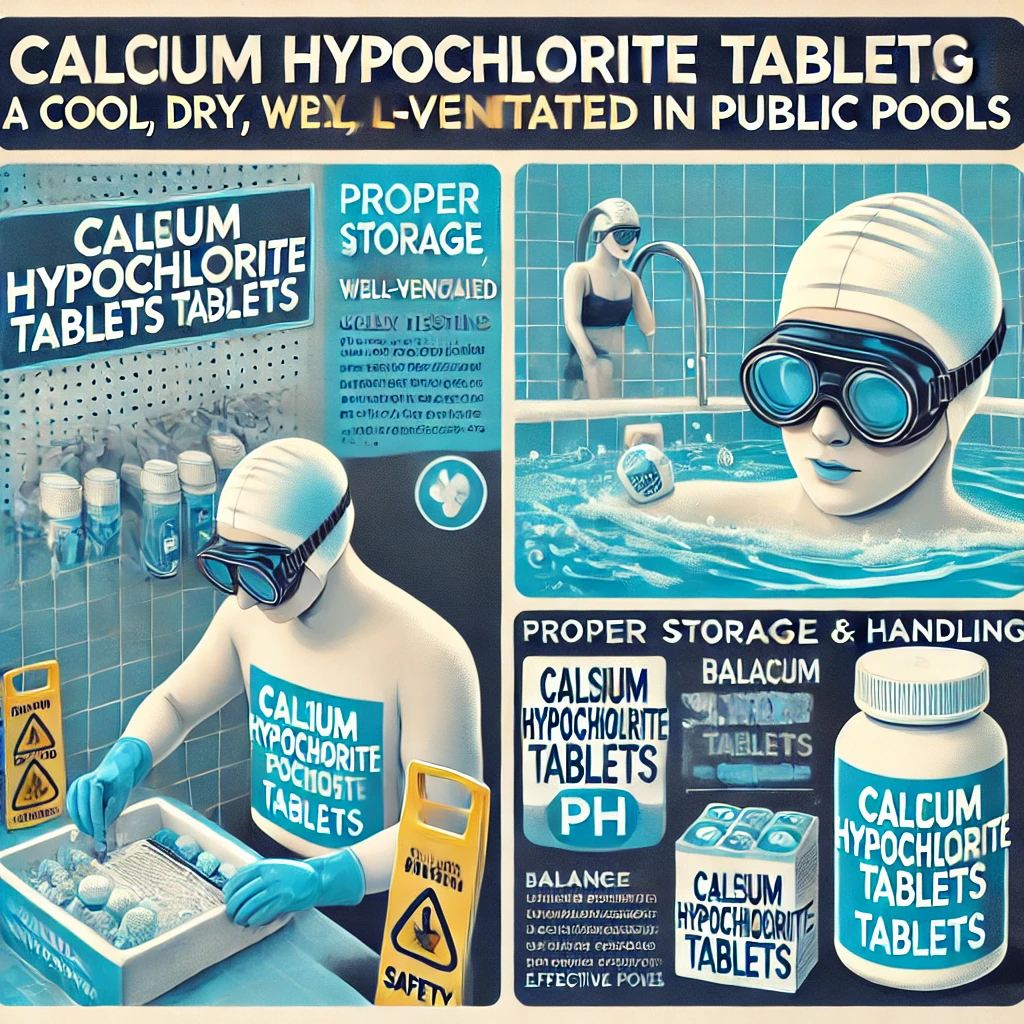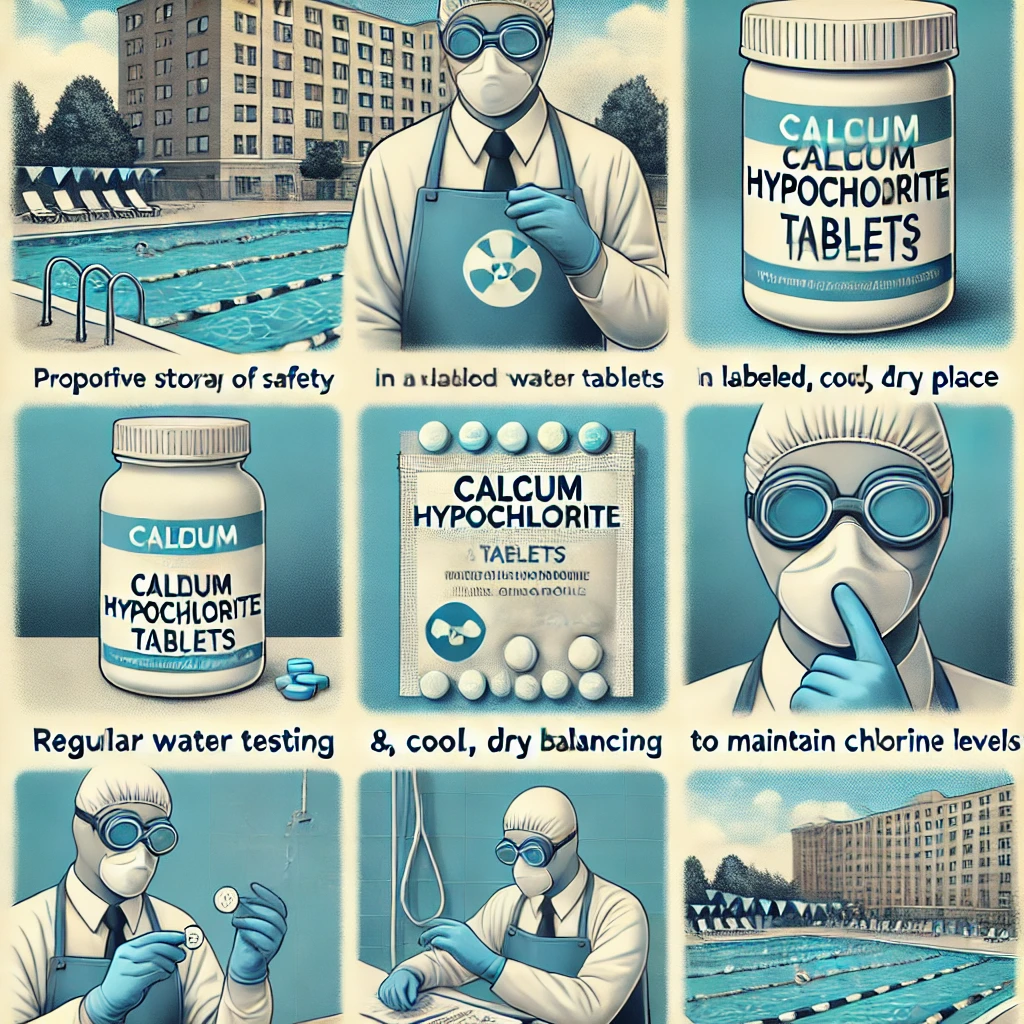Calcium hypochlorite is widely used in public pools to maintain water cleanliness and safety. As a powerful disinfectant, it effectively kills bacteria, viruses, and algae. However, using calcium hypochlorite tablets correctly is essential to ensure both the safety of swimmers and the effectiveness of the treatment. Understanding the best practices for handling, dosing, and monitoring calcium hypochlorite helps pool managers maintain a safe and healthy swimming environment.

I. The Role of Calcium Hypochlorite in Pool Maintenance
Calcium hypochlorite is a chlorine compound commonly used to disinfect public pools. It releases chlorine when dissolved in water, which acts as a powerful sanitizer. Chlorine kills harmful microorganisms, including bacteria, viruses, and algae. By maintaining proper chlorine levels, calcium hypochlorite ensures that the pool water remains safe for swimmers. Its effectiveness depends on proper handling and application.
II. Proper Storage of Calcium Hypochlorite Tablets
Storing calcium hypochlorite tablets correctly is crucial for safety. These tablets should be kept in a cool, dry place. Moisture can cause them to degrade or react prematurely. Store them in a well-ventilated area, away from direct sunlight and heat sources. Ensure that the storage area is out of reach of children and pets. Keep the tablets in their original containers with the lids tightly sealed. Proper storage preserves the effectiveness of the tablets and prevents accidents.
III. Safe Handling Practices
When handling calcium hypochlorite tablets, safety must be a top priority. Always wear protective gloves and eyewear. These tablets can cause skin and eye irritation if handled without protection. Avoid inhaling dust or fumes from the tablets, as they can be harmful. When opening containers, do so in a well-ventilated area. Never mix calcium hypochlorite with other chemicals, especially acids, as this can cause dangerous reactions. Following these safety guidelines minimizes the risk of injury.
IV. Correct Dosage and Application
Using the correct dosage of calcium hypochlorite tablets is essential for maintaining safe chlorine levels in the pool. Over-chlorination can cause irritation to swimmers’ eyes and skin, while under-chlorination can lead to bacteria and algae growth. The recommended dosage varies depending on the pool size and usage. Regularly test the water’s chlorine levels using a reliable test kit. Adjust the dosage based on these readings to ensure the pool remains safe for all users.
V. Monitoring and Maintaining Proper Chlorine Levels
Regular monitoring of chlorine levels is critical for pool safety. Public pools should be tested at least twice a day to ensure that chlorine levels are within the recommended range. The ideal chlorine level for a public pool is between 1 and 3 parts per million (ppm). If levels are too low, harmful microorganisms can thrive. If levels are too high, swimmers may experience skin and eye irritation. Consistent testing and adjustments help maintain a safe and healthy swimming environment.
VI. Responding to Chlorine Imbalances
When chlorine levels become unbalanced, immediate action is required. If chlorine levels are too high, stop adding calcium hypochlorite tablets and allow the levels to decrease naturally. In some cases, adding fresh water can help dilute the chlorine. If levels are too low, additional tablets should be added, and the pool should remain closed until levels are safe. Swift responses to chlorine imbalances prevent potential health risks to swimmers.
VII. Balancing Calcium Hypochlorite with pH Levels
pH levels significantly affect the effectiveness of calcium hypochlorite. The ideal pH range for pool water is between 7.2 and 7.6. If the pH is too high or too low, chlorine becomes less effective at killing harmful microorganisms. Regularly test and adjust the pH levels to ensure that calcium hypochlorite tablets work efficiently. Maintaining balanced pH levels enhances the long-term benefits of using calcium hypochlorite in public pools.
VIII. Educating Pool Staff and Swimmers
Education is key to ensuring the safe use of calcium hypochlorite tablets. Pool staff should be thoroughly trained on the proper use, handling, and storage of these tablets. They should also be aware of the signs of chlorine imbalance and know how to respond effectively. Additionally, educating swimmers about pool rules, such as showering before entering the pool, can help reduce the demand for chlorine. Well-informed staff and swimmers contribute to a safer and more pleasant swimming experience.
IX. Environmental Considerations
While calcium hypochlorite is effective, it’s important to consider its environmental impact. Overuse of chlorine can lead to chemical runoff, which may harm local ecosystems. To minimize this impact, pool managers should adhere to recommended chlorine levels and avoid excessive use. Additionally, using eco-friendly alternatives when possible can reduce the overall environmental footprint of pool maintenance. Balancing effective pool chlorination with environmental responsibility ensures long-term sustainability.
X. Health and Safety Implications
The long-term use of calcium hypochlorite tablets also has health and safety implications. When used correctly, these tablets effectively kill harmful bacteria and pathogens, protecting swimmers from waterborne illnesses. However, over-chlorination can lead to skin irritation, red eyes, and respiratory issues. It’s important to maintain chlorine levels within the recommended range to avoid these problems. By carefully managing calcium hypochlorite, pool managers can provide a safe swimming environment for everyone.

XI. Conclusion
In conclusion, calcium hypochlorite tablets are essential for maintaining the safety and cleanliness of public pools. By following best practices for storage, handling, dosage, and monitoring, pool managers can ensure that these tablets are used effectively and safely. Regular testing and quick responses to chlorine imbalances help protect swimmers from potential health risks. Additionally, educating staff and swimmers on the importance of proper pool maintenance contributes to a safer and more enjoyable swimming environment. Ultimately, the responsible use of calcium hypochlorite tablets is key to ensuring the health and safety of everyone who enjoys public pools.